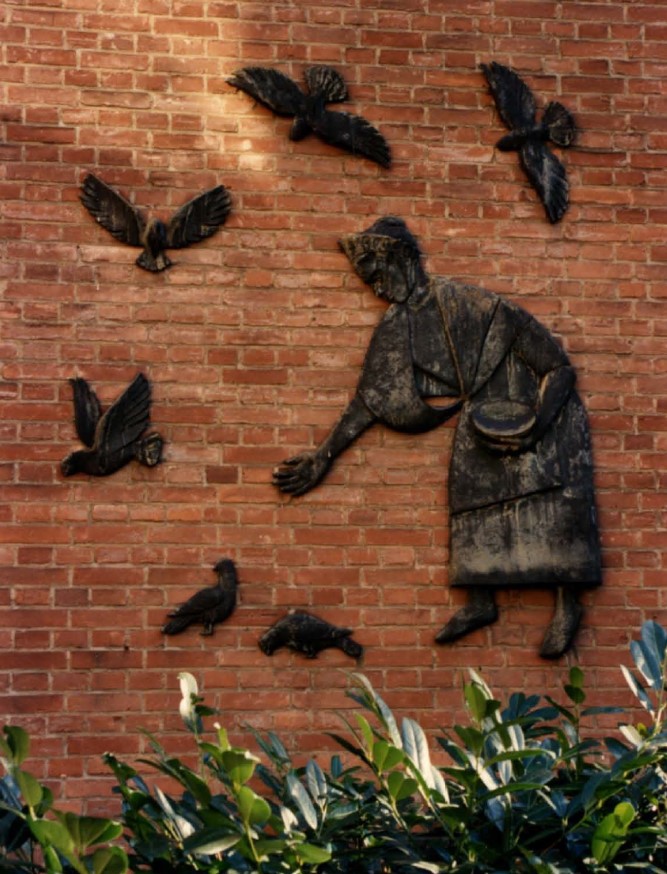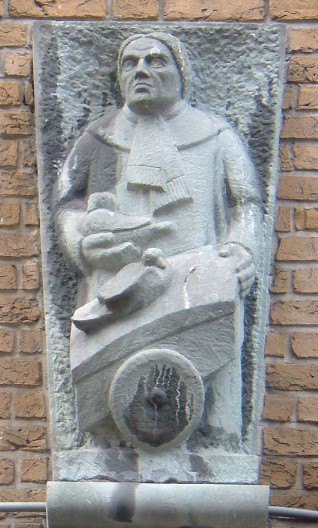During the restoration of 'Het Duivenvrouwtje' the work was given a new patina layer at bronze foundry Custers, this is a process that ensures that all bronze is given the same color.
The Pigeon Woman
Although 'pigeon females' are of all times, two of them have achieved legendary status in Rotterdam. Both were also immortalized in a work of art. Read the story about the pigeon females of Rotterdam here, or take a look at the restored ones yourself Pigeon female by Adri Blok, which recently adorns a facade on the Meent.
Who was the pigeon lady anyway?
That was the widow Petronella Hoendert. Around 1900 she lived on the Grote Kerkplein. With her black cap over her gray hair and her high-necked black dress, she was a neat appearance. She fed the pigeons under the Laurenskerk every day. Her motives were motivated by pure godliness: “I wouldn't take a cent from the congregation. In that feeding I see the ordinance of God. I have to do it, otherwise I am not responsible '. Every week she bought corn kernels for six guilders, because 'that's how I buy the peace of my heart'. Chroniclers also remarked to her: 'There came the pigeon woman, who scooped corn from her primitively crafted cart on pram wheels, let her little eyes wander inquisitively to the roof moldings of the church and to the high tower holes, to start scattering it. Numerous gray, white, and gold-bronze doves descended upon rustling clapping, surrounding her in hundreds of cooing circles. They perkily trotted around with their red legs, swarming with each other, sometimes fluttering up, then flapping their wings, while they greedily pecked the grains. ' In 1962 the Koningin Wilhelmina Kweekschool celebrated its 50th anniversary. One of the gifts was a bronze facade by Petronella Hoendert, The Donion woman, made by Adri Blok.
But there was still a female pigeon?
Yes, there was another well-known pigeon lady. Trijntje van Ham started in 1910 with feeding the wild pigeons on the Grote Kerkplein. She will have often met Petronella Hoendert here. Every day Trijntje also visited the grain offices with a self-built cart to buy grain or obtain it for free. She not only had compassion for the pigeons, but also stray dogs and cats got her attention. She was considered a strange person: children jeered at her and the windows of her house on Van Alkemadeplein were smashed several times. In 1938 the city authorities forbade the pigeon females to feed the birds any longer, because the droppings of the birds would damage buildings and monuments. During the bombing of 14 in May 1940, Trijntje barely managed to escape the blaze, but her house unfortunately did not escape the inferno. During the war years, she was involved in catching feral cats. After the liberation she started a new feed offensive, which now also included ducks and swans. Times have now changed: Trijntje could count on sympathy from now on and was now praised as an animal protector. In 1961 singer Tante Riet (to music by Johnny Hoes) brought the song The pigeon lady of Rotterdam from. 30.000 copies of the gramophone record were sold. A year later, Trijntje died at the age of 92. Sculptor Johan van Berkel immortalized her in one of his façade images on the Minervahuis on the Meent.
Adri Bloks Pigeon female
Sculptor Adriana Cornelia Blok (Rotterdam, 1919-1990) was born in Charlois and received her education at the art academy. She was one of the first Dutch sculptors to make concrete reliefs. Many female sculptors have been active in Rotterdam since the 1950 years, such as Hank Hans, Nel Klaassen, Joeki Simak, Margot Zanstra and Loeki Metz. Adri Blok made a series of images for Rotterdam, including the Drum bearing on the Lijnbaan and the image of Koos Speenhoff on the Oude Binnenweg. For the Queen Wilhelmina Breeding School, Blok paid tribute to Petronella Hoendert, the pigeon woman, who trudged through the streets around the school building for decades with her corn cart.
But after the demolition of the school, to make way for the new construction around the Laurenskerk, the facade was lost. Rotterdammers, newspapers and finally also city council members were increasingly wondering where the image had gone. Recently found BKOR the statue back, somewhere in a shed of the municipality, wrapped in a thick layer of plastic. The "female" was completely restored and the pigeons, which had really disappeared, were again cast in bronze. In short, The Pigeon Woman could return to the city.
But where?
The work should then actually return to the Binnenrotte / Oppert area. Entrepreneur and property owner Robin von Weiler, better known as' Mr. Meent ', offered one of his buildings on the Meent as a carrier for The Pigeon Woman, namely the corner Oppert / Meent, above restaurant Napoli. Here the façade image will be given a second life and the 'lady' can once again cast her gaze on the Laurenskerk.






